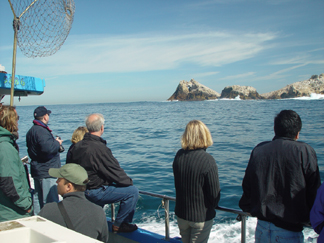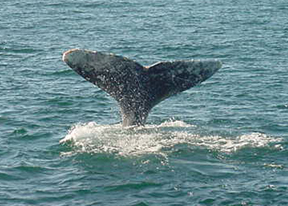 |
| The Farallone Islands are
the main attraction for many who come on Gulf of Farallones
Expeditions tour (Image from www.sfbayimages.com) |
A Whale of a Trip
By Lydia N. Dalloway
To See What They Can See
They come to Sausalito from as far away as Europe and as near
as Novato, San Francisco, Tiburon, or, well, Sausalito, to Gulf of the
Farallones Expeditions to catch a boat leaving the dock at 7 a.m.
What compels a person to leave their warm bed on a weekend
morning before it’s even light out, to take an average of an hour’s drive in
the dark and cold? These adventurers want to experience an expedition to the
Farallon Islands, to get up close and personal with the Pacific Ocean, to
view the California scenery from the sea, and hopefully to see whales,
sharks, dolphins, porpoises, and other marine life.
 |
| Gulf of Farallones
Expeditions helps ordinary people have a real Discovery Channel
experience
www.sfbayimages.com (Image from www.sfbayimages.com) |
A Six-Hour Tour
However daunting, not even the thought of sea-sickness deters passengers
bent on having an experience of a lifetime. Though its efficacy may only be
myth, Gulf of the Farallones Expeditions offers ginger ale with real ginger
to its passengers as a remedy for nausea that some may otherwise experience.
After leaving the docks at 7 a.m. and once past the “Potato Patch,” a short
strip just between the Golden Gate Bridge and Point Bonita known to be the
roughest spot, most passengers are in for smooth sailing for the rest of
their trip.
On board the 50-foot boat, passengers have their choice of
front row seats. They can either stand by the railing or atop the captain’s
deck at the bow of the boat, seek shelter from spray during the choppy
period inside the cabin or captain’s perch, sit on a bench or by the railing
at the spacious stern, or hover along the side of the boat allowing just
enough space for someone to walk past them.
Personal Accounts of the Experience
Santa Rosa residents, Sandy Jones and her husband, were first inspired by
seeing whales at Marine World in Redwood City. Mrs. Jones, who is retired,
said that she was determined to see the graceful creatures in their own
habitat. A previous whale-watching trip in Southern California had proven
fruitless; however, their day with Gulf of the Farallones Expeditions more
than met her expectations, with several whales surfacing during the trip out
to the Farallone Islands and several more during the circuit of the island.
Mrs. Jones said, “I couldn’t get enough of it. My husband
loved it, too. It was so much fun talking to the people because everyone was
excited.” When asked if she would go again, she said, “In a heartbeat.”
Becky Hinderlie, of Fremont, had a different goal in mind.
She had always wanted to see the Farallon Islands. Coming from a family that
grew up sailing, it was only natural for her to take along a big group of
family and friends, including her husband and a niece who got school credit
for reporting what she’d learned on the trip.
It’s no wonder that the Farallone Islands reminded Mrs.
Hinderlie of Hawaii. Their tour date, in October, shone bright and hot. She
said that no one was sitting inside the cabin because it was such a gorgeous
day; some people were even wearing tank tops. Apart from lots of seals and
other marine life, she remembered seeing quite a few humpback whales. “We
spent about an hour circling the islands, but [the boat was going] so slowly
that you don’t realize you’re going around the island,” she said. She was
happy with the photos she took on her trip and wants to go on another boat
tour soon, to a different destination.
Playing Hide-and-Seek with Marine Animals
When asked to name the largest creature that’s ever roamed the earth, most
people might guess the dinosaur. However, whales grow up to three times
larger than the largest dinosaur that ever lived; the tongue of a whale can
weigh as much as a full-grown elephant. How these creatures manage to
successfully play hide-and-seek can only be explained by the contrasting
immensity of the ocean.
 |
| Passengers on Gulf of
Farallones Expeditions come equipped with binoculars and cameras
(Image from www.sfbayimages.com) |
Passengers provide the many eyes needed for this big game
hunt of hide-and-seek. Fortunately, the boat’s crew is familiar with the
favorite hiding places of the whales and steers the boat toward the whale’s
migration pattern, either near the Farallone Islands or, in case of choppy
weather, toward the neighboring shoreline of Point Reyes. The Farallone
Islands have very few humans on them and are a safe haven to 37 types of
endangered species, 13 species of breeding sea birds, and a popular
migrating stop for many types of whales and sharks.
People on the boat spotting live action in the water can
alert their fellow passengers of the sighting using a “clock” system, with
the prow of the boat being 12 o’clock and the stern being 6 o’clock. “Harbor
porpoises at 1 o’clock,” an excited passenger might shout, compelling
binoculars and cameras to point toward the right front side of the boat.
Points of Interest
Gulf of the Farallones Expeditions gives full disclosure: you are only
“guaranteed” to see the Golden Gate Bridge on any given trip. Some tours may
have 20 sightings of whales and others have none. The only way to be sure to
see marine life is to venture out multiple times, which is why Gulf of the
Farallones Expeditions may soon be offering a special “series” pass,
allowing the bearer to sign up for several outings at a discount price.
 |
| Lighthouses are a scenic
and historical part of the Gulf of Farallones Expeditions tour
(Image from www.sfbayimages.com) |
But, don’t despair if time or money only allows you to go
out once, because the points of interest along the way are rich in
California history. Gulf of the Farallones Expeditions usually has a
naturalist on hand to provide educational talks about the California coast
and its inhabitants.
Doreen Moser, who has 14 years of experience as an
interpretive biologist on whale-watching tours, has been working with Gulf
of the Farallones Expeditions for the past couple of months, giving
one-on-one talks throughout the boat. As she sees it, her job is to show
people how marine mammals and other coastal phenomenon are relevant to their
lives.
 |
| “You’re it!” This whale got
caught in a big game hunt of hide-and-seek Photo by: John Rochat |
“The most interesting part of the job,” she said, “is
being out there and not knowing what you’re going to see. Every trip is
different. Also, for many people, this is the first whale they’ve ever
seen.” She enjoys seeing their excitement and expressions of awe when the
whales surface and being there to spot “little things” for people when
whales are winning at the game of hide-and-seek. Commenting on tourists from
around the world who come to experience whale-watching, she said, “It’s
surprising that more people don’t take advantage of the opportunities in
their own back yard. I would encourage people to get out there.”